Impossible Mission / Programmed Trip
 The Game: On an enclosed grid, you control a robotic drone whose job is to collect certain items on the grid and deflect enemies away from those items. If you can plant obstacles – which deflect your enemies with 90-degree left or right turns – that lock your pursuers into an inescapable infinite loop, all the better…but more will come. (Ectron, 1983 [unreleased prototype] / custom copies released in 2006)
The Game: On an enclosed grid, you control a robotic drone whose job is to collect certain items on the grid and deflect enemies away from those items. If you can plant obstacles – which deflect your enemies with 90-degree left or right turns – that lock your pursuers into an inescapable infinite loop, all the better…but more will come. (Ectron, 1983 [unreleased prototype] / custom copies released in 2006)
The Game: An interesting unreleased game which was apparently developed for the South American market (where the Odyssey2, known simply as the Odyssey, was quite the success story) by an outfit called Ectron, Mission Impossible / Programmed Trip is a little like playing a video game by programming in a visual variant of the LOGO programming language.
Happy Trails
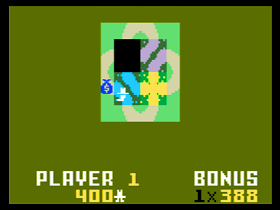 The Game: Players control a lawman hot on the trail of a notorious bank robber – a notoriously messy one, it should be noted, since his loot is scattered all over the place. Using the controller, pieces of the maze can be shifted (even while one of the characters is on it) to allow the sheriff to recover the money and capture the bad guy, but while leaving a character going in circles momentarily, letting him wander into the open gap in the maze will cost a precious life. Clearing the maze will restart the chase anew, on a bigger and more complex maze. (Activision, 1983)
The Game: Players control a lawman hot on the trail of a notorious bank robber – a notoriously messy one, it should be noted, since his loot is scattered all over the place. Using the controller, pieces of the maze can be shifted (even while one of the characters is on it) to allow the sheriff to recover the money and capture the bad guy, but while leaving a character going in circles momentarily, letting him wander into the open gap in the maze will cost a precious life. Clearing the maze will restart the chase anew, on a bigger and more complex maze. (Activision, 1983)
Memories: The first Activision title for Intellivision that wasn’t simply an Intellivision version of an Atari 2600 game, Happy Trails raised some serious hackles with the makers of the machine it on which it was designed to run.
Tutankham
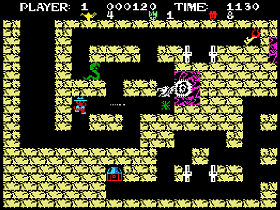 The Game: As an intrepid, pith-helmeted explorer, you’re exploring King Tut’s catacombs, which are populated by a variety of killer bugs, birds, and other nasties. You’re capable of firing left and right, but not vertically – so any oncoming threats from above or below must be outrun or avoided. Warp portals will instantly whisk you away to other parts of the maze (though this doesn’t necessarily mean safer). Gathering all of the treasures and keys will allow you to open the vault at the end of each level…which leads to the next, and even more difficult level. (Parker Brothers, 1983)
The Game: As an intrepid, pith-helmeted explorer, you’re exploring King Tut’s catacombs, which are populated by a variety of killer bugs, birds, and other nasties. You’re capable of firing left and right, but not vertically – so any oncoming threats from above or below must be outrun or avoided. Warp portals will instantly whisk you away to other parts of the maze (though this doesn’t necessarily mean safer). Gathering all of the treasures and keys will allow you to open the vault at the end of each level…which leads to the next, and even more difficult level. (Parker Brothers, 1983)
Memories: If there was a better home version of this arcade sleeper hit to emerge during the 1980s, I haven’t seen it yet. Parker Brothers’ Colecovision edition of Tutankham does everything a good console port of a coin-op should do – it brings the game play, as well as the audiovisual elements, home – and this version does it in spades. It looks like it, it sounds like it, and it plays like it.
Turtles!
 The Game: As the mama turtle, you trundle around a simple maze, pursued by nasty bugs which are lethal to the touch. You can drop bombs in their path, which will reduce their speed (and this device really does beg all sorts of biological double-entendres, doesn’t it?). Your mission is to visit the isolated cul-de-sacs in the maze – which in itself can lead to your turtle getting trapped – to retrieve your eggs and take them to safe houses dotted around the maze. If you visit the wrong place at the wrong time, you’ll wind up with not an egg, but a new bug hot on your heels. Getting all your turtle eggs to safety takes you to the next level, and eventually everything winds up moving so fast, you haven’t got a chance. (North American Philips [under license from Stern], 1983)
The Game: As the mama turtle, you trundle around a simple maze, pursued by nasty bugs which are lethal to the touch. You can drop bombs in their path, which will reduce their speed (and this device really does beg all sorts of biological double-entendres, doesn’t it?). Your mission is to visit the isolated cul-de-sacs in the maze – which in itself can lead to your turtle getting trapped – to retrieve your eggs and take them to safe houses dotted around the maze. If you visit the wrong place at the wrong time, you’ll wind up with not an egg, but a new bug hot on your heels. Getting all your turtle eggs to safety takes you to the next level, and eventually everything winds up moving so fast, you haven’t got a chance. (North American Philips [under license from Stern], 1983)
Memories: This simple rendition of an extremely obscure Stern arcade game has to rank as one of the most addictive Odyssey 2 games ever made, and it quickly puts the lie to the common misconception that the Odyssey would have been useless for home versions of arcade games anyway.
Trans-American Rally
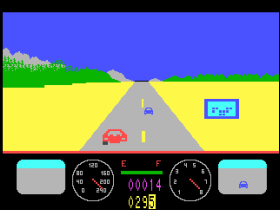 The Game: The Videopac puts you in the driver’s seat for a cross-country race. Avoid other cars and obstacles and stay on the road; hitting too many oncoming vehicles causes you to forfeit the race. (Philips, 1983)
The Game: The Videopac puts you in the driver’s seat for a cross-country race. Avoid other cars and obstacles and stay on the road; hitting too many oncoming vehicles causes you to forfeit the race. (Philips, 1983)
Memories: A surprising game on the Videopac G7400+ (the European equivalent of the cancelled Odyssey3 console), Trans-American Rally is an example of a game done almost entirely in the “extended” graphics set. The only hints of the original Odyssey2/Videopac fixed graphics set is the use of the old “triangle” elements to draw the road and to draw any unchanging areas of solid colors (such as the desert on either side of the road). The rest of the graphics are done entirely in the “plus” graphics, and the game looks surprisingly good for anything running on the Videopac platform: it’s on a par with many a TI 99/4a game.
Time Pilot
 The Game: You’re flying solo through the fourth dimension! In what must be the least subtle time-traveling intervention since the last time there was a time travel episode on Star Trek: Voyager, you’re blasting your way through dozens of aircraft from 1940 through 1982. From WWII-era prop planes, to Vietnam-era helicopters, to 1982, where you confront jet fighters with the same maneuverability as your plane, you’re in for quite a wild ride. Rescue parachutists and complete the level by destroying “boss” craft such as heavy planes and dirigibles. (Coleco, 1983)
The Game: You’re flying solo through the fourth dimension! In what must be the least subtle time-traveling intervention since the last time there was a time travel episode on Star Trek: Voyager, you’re blasting your way through dozens of aircraft from 1940 through 1982. From WWII-era prop planes, to Vietnam-era helicopters, to 1982, where you confront jet fighters with the same maneuverability as your plane, you’re in for quite a wild ride. Rescue parachutists and complete the level by destroying “boss” craft such as heavy planes and dirigibles. (Coleco, 1983)
Memories: Coleco‘s home version of Time Pilot for the Atari 2600 is one of the company’s better arcade ports for that machine, and yet so much of what made the arcade game such a memorable experience was left behind. I can accept the watering-down of the game’s graphics, especially when an effort was obviously made to keep them flicker-free – an impressive feat for this game. But some of what’s left out includes the game’s very objectives.
Time Pilot
 The Game: You’re flying solo through the fourth dimension! In what must be the least subtle time-traveling intervention since the last time there was a time travel episode on Star Trek: Voyager, you’re blasting your way through
The Game: You’re flying solo through the fourth dimension! In what must be the least subtle time-traveling intervention since the last time there was a time travel episode on Star Trek: Voyager, you’re blasting your way through  dozens of aircraft from 1940 through 1982. From WWII-era prop planes, to Vietnam-era helicopters, to 1982, where you confront jet fighters with the same maneuverability as your plane, you’re in for quite a wild ride. Rescue parachutists and complete the level by destroying “boss” craft such as heavy planes and dirigibles. (Coleco, 1983)
dozens of aircraft from 1940 through 1982. From WWII-era prop planes, to Vietnam-era helicopters, to 1982, where you confront jet fighters with the same maneuverability as your plane, you’re in for quite a wild ride. Rescue parachutists and complete the level by destroying “boss” craft such as heavy planes and dirigibles. (Coleco, 1983)
Memories: As well-intentioned as Coleco’s translation of the Centuri-licensed Konami classic was, and even as powerful as the ColecoVision is, it wasn’t quite up to the challenge of Time Pilot.
Threshold
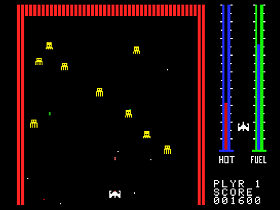 The Game: Players control a space fighter on patrol as alien attack fleets gather in deep space. Always keeping a wary eye on his ship’s fuel and laser temperature, would-be space heroes must blow away every alien ship on the screen before collecting the reward – namely, the privelege of blowing away another wave of alien attackers. (Sierra On-Liine, 1983)
The Game: Players control a space fighter on patrol as alien attack fleets gather in deep space. Always keeping a wary eye on his ship’s fuel and laser temperature, would-be space heroes must blow away every alien ship on the screen before collecting the reward – namely, the privelege of blowing away another wave of alien attackers. (Sierra On-Liine, 1983)
Memories: Another of Sierra’s early forays into non-computer game software via its “Sierravision” imprint, Threshold admittedly fills a gap in the Colecovision library – that system somehow managed to avoid accumulating heaps of slide-and-shoot Space Invaders derivatives. But it doesn’t do it particularly well, as Threshold is simply a watered-down Colecovision edition of Astro Blaster.
The Texas Chainsaw Massacre
 The Game: You’re Leatherface, the notorious killer, and your job is pretty simple: track down those meddling teenagers (a prerequisite for every horror flick) and slice ‘n’ dice them with your chainsaw. Simple enough, right? It would be if not for obstacles that block your path (some of which you can also dispose of with your chainsaw), and the fact that – get this – these kids scream and run away from you. The nerve! But you can sever that nerve, and all the others, with your chainsaw…at least until it runs out of fuel. (Wizard, 1983)
The Game: You’re Leatherface, the notorious killer, and your job is pretty simple: track down those meddling teenagers (a prerequisite for every horror flick) and slice ‘n’ dice them with your chainsaw. Simple enough, right? It would be if not for obstacles that block your path (some of which you can also dispose of with your chainsaw), and the fact that – get this – these kids scream and run away from you. The nerve! But you can sever that nerve, and all the others, with your chainsaw…at least until it runs out of fuel. (Wizard, 1983)
Memories: Wizard Games was a short-lived outfit that sprang up during that fleeting, fertile window of time when it seemed like anyone could make a mint doing Atari 2600 games – or at least everyone thought they could. With this and a similar game based on John Carpenter’s legendary Halloween (in which the player tried to escape from killer Michael Myers), Wizard put itself on the map instantly. Not with great games, mind you, but with pure controversy: at the time, these games were decried for gore and violence!
Tac-Scan
 The Game: Commanding a fleet of ships, you use their combined firepower to wipe out an onslaught of alien ships (which, perhaps not at all surprisingly, are firing back at you). It only takes one hit to lose one of your own fleet, and when your fleet is completely wiped out, the game is over. Until then, do as much damage to the enemy armada as you can. (Sega, 1983)
The Game: Commanding a fleet of ships, you use their combined firepower to wipe out an onslaught of alien ships (which, perhaps not at all surprisingly, are firing back at you). It only takes one hit to lose one of your own fleet, and when your fleet is completely wiped out, the game is over. Until then, do as much damage to the enemy armada as you can. (Sega, 1983)
Memories: I always had a certain fascination for the arcade game that inspired this somewhat hard-to-find 2600 cartridge, but it seems to have lost something in the translation…oh yes, the split-second control required to play the bloody thing, that’s it. Somewhere in the definition of “frustration” must be “playing Tac-Scan on the Atari 2600.”
Super Cobra
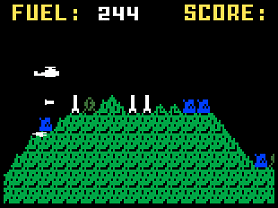 The Game: You’re piloting a heavily armed helicopter straight into a heap o’ trouble. Ground and air defenses have been mounted in this enemy installation to stop you at any costs. Missiles, anti-aircraft turrets, and even other vehicles will See the videodo anything to knock you out of the sky – and given the chunky terrain, the odds are in favor of the house. Your only saving grace is that you’re armed to the teeth. But, as you may have guessed by now, even that may not be enough to save you. (Parker Brothers, 1983)
The Game: You’re piloting a heavily armed helicopter straight into a heap o’ trouble. Ground and air defenses have been mounted in this enemy installation to stop you at any costs. Missiles, anti-aircraft turrets, and even other vehicles will See the videodo anything to knock you out of the sky – and given the chunky terrain, the odds are in favor of the house. Your only saving grace is that you’re armed to the teeth. But, as you may have guessed by now, even that may not be enough to save you. (Parker Brothers, 1983)
Memories: Parker Brothers may have been an old hand at board games, but it was a youngster in the video game business. Still, all that clout from its industry-dominating board game operation didn’t hurt, helping Parkers secure major hit licenses that no other young video game operation could’ve scored: Frogger, Q*Bert, and let’s not forget the very first Star Wars home video games. In the middle of this stellar line-up was… Super Cobra.
Super Cobra
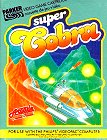 The Game: You’re piloting a heavily armed helicopter straight into a heap o’ trouble. Ground and air defenses have been mounted in this enemy installation to stop you at any costs. Missiles, anti-aircraft turrets, and even other vehicles will do anything to knock you out of the sky – and given the chunky terrain, the odds are in favor of the house. Your only saving grace is that you’re armed to the teeth. But, as you may have guessed by now, even that may not be enough to save you. (Supposedly, according to Konami, Super Cobra was their sequel to the minor arcade hit Scramble.) (Parker Brothers, 1983)
The Game: You’re piloting a heavily armed helicopter straight into a heap o’ trouble. Ground and air defenses have been mounted in this enemy installation to stop you at any costs. Missiles, anti-aircraft turrets, and even other vehicles will do anything to knock you out of the sky – and given the chunky terrain, the odds are in favor of the house. Your only saving grace is that you’re armed to the teeth. But, as you may have guessed by now, even that may not be enough to save you. (Supposedly, according to Konami, Super Cobra was their sequel to the minor arcade hit Scramble.) (Parker Brothers, 1983)
Memories: Alas, Konami’s Super Cobra didn’t fare quite as well on the Odyssey2 as Q*Bert did. At times, it’s almost comical – a few seconds of fast and furious on-screen action are followed by a tedious scroll to the left as the playing field is filled with the next round of extremely inhospitable terrain!
Stargate
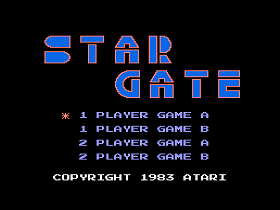 The Game: The alien abductors are back. Their henchbeings are back. And fortunately for the hapless humans on the planet’s surface, you’re back too, in a fully armed warship with a belly full of smart bombs. But the aliens have brought new and unusual reinforcements, and now the ultimate X-factor is seen visibly floating in the night sky – a stargate which could deposit your space fighter anywhere, delivering you to safety…or a rendezvous with a swarm of aliens. (Atari, 1983)
The Game: The alien abductors are back. Their henchbeings are back. And fortunately for the hapless humans on the planet’s surface, you’re back too, in a fully armed warship with a belly full of smart bombs. But the aliens have brought new and unusual reinforcements, and now the ultimate X-factor is seen visibly floating in the night sky – a stargate which could deposit your space fighter anywhere, delivering you to safety…or a rendezvous with a swarm of aliens. (Atari, 1983)
Memories: Released only in Japan in the initial burst of titles for the Famicom, this port of Williams Electronics‘ arcade sequel Stargate (also known as Defender II, a title to which the game was switched to reinforce its status as a sequel to the hit Defender). The territory-limited reach of the game is the bad news. The good news? It’s an exceptional arcade port that might just have become this reviewer’s favorite way to enjoy a legendarily difficult game.
Star Wars: Jedi Arena
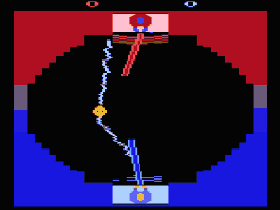 The Game: You weren’t born with a lightsaber in your hands. Even a Jedi Knight must practice his skills. Two Jedi are safely tucked away behind deflector shields, while an automatic seeker ball roams the center of a large chamber. You can use the Force to influence the seeker to attack your opponent, and you can deflect the seeker’s laser bolts when your opponent does the same to you. And every once in a while, the seeker goes into berzerk mode, firing multiple bolts at both contestants, pummeling their shields until one or both are defenseless. (Parker Brothers, 1983)
The Game: You weren’t born with a lightsaber in your hands. Even a Jedi Knight must practice his skills. Two Jedi are safely tucked away behind deflector shields, while an automatic seeker ball roams the center of a large chamber. You can use the Force to influence the seeker to attack your opponent, and you can deflect the seeker’s laser bolts when your opponent does the same to you. And every once in a while, the seeker goes into berzerk mode, firing multiple bolts at both contestants, pummeling their shields until one or both are defenseless. (Parker Brothers, 1983)
Memories: Easily the strangest of Parker Bros.‘ Star Wars-inspired games for the 2600, I have to give Jedi Arena full marks for originality – instead of trying to ape a scene from any of the films in a convoluted game structure, Parker Brothers instead opted to create a completely new scenario, based only loosely on Luke’s training scene with the seeker ball in Star Wars.
Star Trek
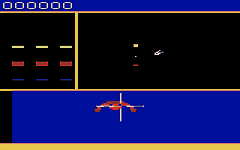 The Game: Welcome to the bridge. Your mission is to travel from sector to sector, eliminating Klingon incursions into Federation space without getting your ship and crew destroyed. Friendly starbases offer aid and allow you to make resupply stops so you can keep up the good fight – and you do have to keep a careful eye on your phaser, shield and warp power… (Sega, 1983)
The Game: Welcome to the bridge. Your mission is to travel from sector to sector, eliminating Klingon incursions into Federation space without getting your ship and crew destroyed. Friendly starbases offer aid and allow you to make resupply stops so you can keep up the good fight – and you do have to keep a careful eye on your phaser, shield and warp power… (Sega, 1983)
 Memories: Sega‘s own adaptation of its arcade game wasn’t bad. Though the Atari VCS, by its very nature, tends to force programmers to make trade-offs for game play that rob arcade adaptations of some of their luster, this one actually came out okay. If anything, this version of Star Trek was simpler than its arcade forebear – and since “bear” is the operative word for the coin-op, for once this isn’t a bad thing.
Memories: Sega‘s own adaptation of its arcade game wasn’t bad. Though the Atari VCS, by its very nature, tends to force programmers to make trade-offs for game play that rob arcade adaptations of some of their luster, this one actually came out okay. If anything, this version of Star Trek was simpler than its arcade forebear – and since “bear” is the operative word for the coin-op, for once this isn’t a bad thing.
Spike!
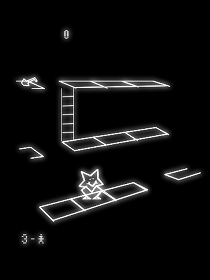 The Game: Poor Spike – his girlfriend Molly has been snatched by a beastly enemy, and it’s up to Spike to rescue her (after, of course, declaring “Darnit!”). Spike must climb his way up several ever-moving platforms. He can change the position of the ladders he uses to climb up these platforms, but it’s not as easy as simply reaching the top: to advance to the next level, Spike has to grab a key. Beastly henchmen scoot along the platforms to bump Spike off to his death, but Spike can kick them away momentarily. (GCE, 1983)
The Game: Poor Spike – his girlfriend Molly has been snatched by a beastly enemy, and it’s up to Spike to rescue her (after, of course, declaring “Darnit!”). Spike must climb his way up several ever-moving platforms. He can change the position of the ladders he uses to climb up these platforms, but it’s not as easy as simply reaching the top: to advance to the next level, Spike has to grab a key. Beastly henchmen scoot along the platforms to bump Spike off to his death, but Spike can kick them away momentarily. (GCE, 1983)
Memories: The first voice-synthesis game for GCE‘s already wildly innovative Vectrex console, Spike missed being the first home video game to produce voice synthesis without additional hardware by mere months (wait for it, wait for it… “Darnit!”). (The prize, if anyone’s counting, went to Atari‘s RealSports Baseball for the Atari 5200.) But that’s not the only neat trick Spike! brought to the table.
Shuttle Orbiter
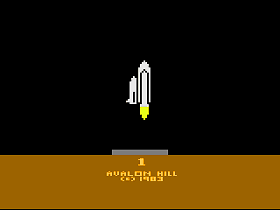 The Game: Piloting the space shuttle, you must navigate your way from a low orbit to a high one, stopping at a refueling satellite and ferrying modules to a space station under construction. While gaining altitude, you may run through fields of space debris; allowing them to hit the shuttle costs you precious fuel. (Avalon Hill, 1983)
The Game: Piloting the space shuttle, you must navigate your way from a low orbit to a high one, stopping at a refueling satellite and ferrying modules to a space station under construction. While gaining altitude, you may run through fields of space debris; allowing them to hit the shuttle costs you precious fuel. (Avalon Hill, 1983)
Memories: Ah…simpler times. Truth be told, I love space exploration games – no alien encounters, no blasting doomsday asteroids out of a collision course with Earth, none of that. Just get the job done and get home safely.
Spider-Man
 The Game: The Green Goblin and his henchmen are terrorizing the city once more, and it’s up to Spider-Man to restore order. But the odds are against him: he can only attach his web to the surface of the building, naturally, but the Goblin’s underlings are ready and eager to cut Spidey’s web should it be planted near them. Worse yet, the difficult-to-navigate high voltage tower at the top of the building is riddled with the Goblin’s bombs, and even if Spidey can defuse them, there’s a Super Bomb waiting for him at the top of the building – and he can only put it out of commission after dealing with the Green Goblin personally. (Parker Brothers, 1983)
The Game: The Green Goblin and his henchmen are terrorizing the city once more, and it’s up to Spider-Man to restore order. But the odds are against him: he can only attach his web to the surface of the building, naturally, but the Goblin’s underlings are ready and eager to cut Spidey’s web should it be planted near them. Worse yet, the difficult-to-navigate high voltage tower at the top of the building is riddled with the Goblin’s bombs, and even if Spidey can defuse them, there’s a Super Bomb waiting for him at the top of the building – and he can only put it out of commission after dealing with the Green Goblin personally. (Parker Brothers, 1983)
 Memories: What if…Crazy Climber was mad as hell and wasn’t going to take it any more? That’s almost what Spider-Man seems like on the Atari 2600. Though I will step away from the comparison and point out that Spider-Man is a lot more challenging than the 2600’s less than stellar rendition of Crazy Climber. Simply getting a “foothold” (web-hold?) for your next ascent is a huge challenge, and getting to your next temporary destination is always a dicey deal. Unlike that other scaler of buildings, however, Spidey can catch himself in mid-fall – if he’s in the right place and you’re really fast.
Memories: What if…Crazy Climber was mad as hell and wasn’t going to take it any more? That’s almost what Spider-Man seems like on the Atari 2600. Though I will step away from the comparison and point out that Spider-Man is a lot more challenging than the 2600’s less than stellar rendition of Crazy Climber. Simply getting a “foothold” (web-hold?) for your next ascent is a huge challenge, and getting to your next temporary destination is always a dicey deal. Unlike that other scaler of buildings, however, Spidey can catch himself in mid-fall – if he’s in the right place and you’re really fast.
Spectron
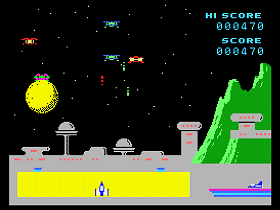 The Game: Aliens are closing in on your planetary base, and apparently you’re the only one on call to fend them off. Shields protect your ground-hugging mobile cannon, but they tend to be eroded away quickly by both incoming enemy fire and your own shots from the ground. If enemy ships infiltrate your protective bunker, you can find yourself in a very close-quarters firefight. When you eliminate a wave of alien ships, the next wave moves in to attack. (Spectravideo, 1983)
The Game: Aliens are closing in on your planetary base, and apparently you’re the only one on call to fend them off. Shields protect your ground-hugging mobile cannon, but they tend to be eroded away quickly by both incoming enemy fire and your own shots from the ground. If enemy ships infiltrate your protective bunker, you can find yourself in a very close-quarters firefight. When you eliminate a wave of alien ships, the next wave moves in to attack. (Spectravideo, 1983)
Memories: “Oh no!” you might be saying, “Not another Space Invaders clone!” But the thing is, as obvious a genre of game as that might have been on nearly every other console in existence, Spectron is one of the very few such games that was released for the Colecovision during the console’s heyday.
Space Shuttle: A Journey Into Orbit

 The Game: You’re the pilot of the space shuttle. And the mission specialist too, apparently. (Hey, everyone’s making staffing cutbacks these days.) You must keep the orbiter on target during launch, not allowing it to drift off course, and then you must retrieve, repair and re-deploy a satellite. Then augur the shuttle in for a smooth landing – and then get in line for your next mission, which begins almost immediately after your previous one. (Did we mention that, in this game’s universe, you’re NASA’s only shuttle pilot and mission specialist?) (Activision, 1983)
The Game: You’re the pilot of the space shuttle. And the mission specialist too, apparently. (Hey, everyone’s making staffing cutbacks these days.) You must keep the orbiter on target during launch, not allowing it to drift off course, and then you must retrieve, repair and re-deploy a satellite. Then augur the shuttle in for a smooth landing – and then get in line for your next mission, which begins almost immediately after your previous one. (Did we mention that, in this game’s universe, you’re NASA’s only shuttle pilot and mission specialist?) (Activision, 1983)
Memories: Activision‘s excessively cool shuttle flight sim piqued my interest just as a later Apple II resource-management game, Project Space Station, did. I’ve always liked the idea of a modern-day (or five-minutes-into-the-future, as was the case with Project) space sim that doesn’t involve blowing stuff up.
Sorcerer
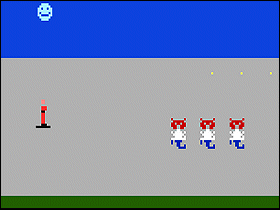 The Game: You’re the sorcerer, and your first job is to commandeer a magic flying carpet-lookin’ thing that zips randomly through the air above you, taunting you. Once a carpet flies low enough for you to board it (simply by moving the joystick up), you can go to the right and begin doing battle with all manners of magical adversaries, including trios of non-descript guys and lizards that look like they’ve been decorated for a Fourth of July parade. If they shoot you, you fall off your flying carpet and your body drifts lifelessly to the bottom of the screen. If you shoot them first, they inexplicably transform into treasures that you can pick up before going to the next screen. (Mythicon, 1983)
The Game: You’re the sorcerer, and your first job is to commandeer a magic flying carpet-lookin’ thing that zips randomly through the air above you, taunting you. Once a carpet flies low enough for you to board it (simply by moving the joystick up), you can go to the right and begin doing battle with all manners of magical adversaries, including trios of non-descript guys and lizards that look like they’ve been decorated for a Fourth of July parade. If they shoot you, you fall off your flying carpet and your body drifts lifelessly to the bottom of the screen. If you shoot them first, they inexplicably transform into treasures that you can pick up before going to the next screen. (Mythicon, 1983)
Memories: I remember sitting in a crowd at the Classic Gaming Expo auction in 2003 and hearing John Hardie pitch the next item – a minty-fresh Mythicon point-of-sale display stocked with still-shrinkwrapped Mythicon game cartridges for the 2600 – as a bunch of games that were essentially the same. I thought he was joking. Now that I have played Sorcerer for myself – having already played and reviewed Firefly here – I have learned that John speaks the truth.
Sky Jinks
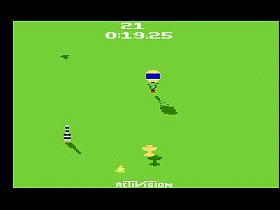
 The Game: It’s a lovely day for a little bit of prop flying. You’re at the stick of a small, single-engine plane, and you must complete an increasingly difficult succession of courses where you must pass different colored pylons on the left or right. But there are obstacles that don’t make this easy – several balloonists also agree that it’s a good day to take to the air, and then there are the trees… (Activision, 1983)
The Game: It’s a lovely day for a little bit of prop flying. You’re at the stick of a small, single-engine plane, and you must complete an increasingly difficult succession of courses where you must pass different colored pylons on the left or right. But there are obstacles that don’t make this easy – several balloonists also agree that it’s a good day to take to the air, and then there are the trees… (Activision, 1983)
Memories: I can’t tell you how many hours I spent with this game as a kid. It drove me nuts! I could whip around like a flying ace on the easy courses, but never failed to wipe out on the more advanced ones.
Rocky Super Action Boxing
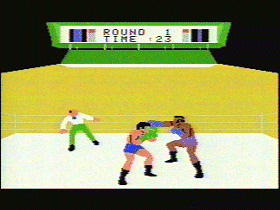 The Game: Spin up “Eye Of The Tiger” on your turntable, power up your Colecovision, and get ready to go ten rounds with Clubber Lang. If you think you’re tough enough to take on a digital Mr. T, take a swing at helping Rocky Balboa reign victorious once more. Just be ready to taste the mat along the way too. (Coleco, 1983)
The Game: Spin up “Eye Of The Tiger” on your turntable, power up your Colecovision, and get ready to go ten rounds with Clubber Lang. If you think you’re tough enough to take on a digital Mr. T, take a swing at helping Rocky Balboa reign victorious once more. Just be ready to taste the mat along the way too. (Coleco, 1983)
Memories: Alas, my feelings on video boxing are a lot like my feelings on video pinball: once you take either activity into the virtual realm and remove the inherent physicality of it, sure, you might be able to nail the look and sounds of boxing or pinball, or just about any other sport, but in so doing you’ve lost so much of the essence that it’s almost a meaningless exercise.
Robin Hood / Sir Lancelot
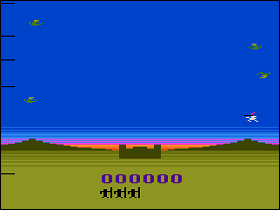 The Game: In Sir Lancelot, players assume the role of the legendary knight atop his flying steed (who knew that the Arthurian mythos could be mixed with the Greek legend of Pegasus?), battling a sky seething with dragons. Killing all the dragons on the screen will advance Lancelot to another level featuring a “boss” dragon and a damsel awaiting rescue.
The Game: In Sir Lancelot, players assume the role of the legendary knight atop his flying steed (who knew that the Arthurian mythos could be mixed with the Greek legend of Pegasus?), battling a sky seething with dragons. Killing all the dragons on the screen will advance Lancelot to another level featuring a “boss” dragon and a damsel awaiting rescue.
In Robin Hood, players don’t exactly get to rob from the rich and give to the poor; instead, the game involves hiding in the forest and exchanging volleys of arrows with the Sheriff of Nottingam and his thugs. (Xonox, 1983)
Memories: Other games archived in Phosphor Dot Fossils were produced by companies that had never produced video games before, and have never produced video games again – companies like Purina and U.S. Games, owned by Quaker Oats. Many of these johnny-come-lately entrants in the video game race knew they weren’t in it for the long haul: they were simply cashing in on a fad, and taking advantage that games could be made for the Atari 2600 without Atari‘s permission or oversight. The glut of low-quality product had a lot to do with the crash of the video game industry, but not everyone who got into the video game biz circa 1982 or ’83 was consciously pumping out stinkers.
Robot Tank
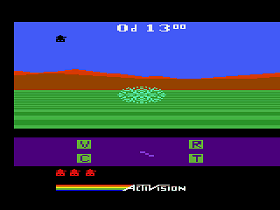
 The Game: So much for the tank platoon. You’re in charge of a lone robotic tank on a battlefield buzzing with bad guys. A radar sweep gives you advance notice of approaching enemies, but there are so many of them out there that even that warning may not come soon enough. A series of critically-placed blasts could leave you immobile, or worse yet, unarmed and helpless to do anything but take a pounding until it’s all over. Repair systems can restore these lost abilities – if you survive that long. The fighting doesn’t stop at night either – the sun goes down, leaving you in the dark for several minutes, capable of fighting and navigating only by instrumentation with little in the way of visual cues. (Activision, 1983)
The Game: So much for the tank platoon. You’re in charge of a lone robotic tank on a battlefield buzzing with bad guys. A radar sweep gives you advance notice of approaching enemies, but there are so many of them out there that even that warning may not come soon enough. A series of critically-placed blasts could leave you immobile, or worse yet, unarmed and helpless to do anything but take a pounding until it’s all over. Repair systems can restore these lost abilities – if you survive that long. The fighting doesn’t stop at night either – the sun goes down, leaving you in the dark for several minutes, capable of fighting and navigating only by instrumentation with little in the way of visual cues. (Activision, 1983)
Memories: Just as Activision beat Parker Bros.‘ rendition of Frogger to the punch with Freeway, they also bested Atari’s own unexpectedly impressive Atari 2600 port of Battlezone with their own first-person tank entry, Robot Tank. Designed and programmed by Alan Miller, Robot Tank has some of Activision’s familiar signatures – the near-impossible color palette they squeezed out of the 2600, the almost flicker-free graphics, and just plain addictive game play. But in this case, Atari’s home version of Battlezone was no slouch either, so it’s hard to pick a clear winner.
River Raid
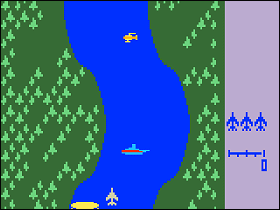 The Game: You’re piloting a fighter jet on a canyon run through enemy territory. You can’t fly outside the canyon walls, so stay over the river and blast everything in sight. Well, almost everything – flying your plane on top of “FUEL” buoys instead of shooting them puts a little bit of gas in the tank, and if you run out of fuel, you might as well just swallow the next enemy bullet, because you’re goin’ down. (Activision, 1983)
The Game: You’re piloting a fighter jet on a canyon run through enemy territory. You can’t fly outside the canyon walls, so stay over the river and blast everything in sight. Well, almost everything – flying your plane on top of “FUEL” buoys instead of shooting them puts a little bit of gas in the tank, and if you run out of fuel, you might as well just swallow the next enemy bullet, because you’re goin’ down. (Activision, 1983)
Memories: Early in Activision‘s foray into publishing games for the Intellivision, the company issued a strange edict to its programmers: if it was a port of a game also released for the Atari VCS, don’t make the game look significantly different from the Atari version. River Raid is a good example of what happened once Activision abandoned that extremely odd policy.
Return of the Jedi: Death Star Battle
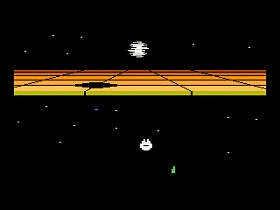 The Game: Presumably, you play the part of Lando Calrissian in this game, which seems to follow the events in the latter half of the film Return of the Jedi. Piloting the Millennium Falcon, you dart around the perimeter defense shield of the Empire’s new Death Star, which is still being constructed before your very eyes. You must eliminate a certain number of TIE Interceptors before a hole opens in the shield, allowing you to get close enough to start blowing pieces out of the Death Star itself. But an automatic defense system won’t take long to track you down and eliminate you, so you have to work fast. The sooner you can hit the Death Star power core, the better. And when you accomplish that, you have to worry about dodging the flaming debris of the huge space station… (Parker Brothers, 1983)
The Game: Presumably, you play the part of Lando Calrissian in this game, which seems to follow the events in the latter half of the film Return of the Jedi. Piloting the Millennium Falcon, you dart around the perimeter defense shield of the Empire’s new Death Star, which is still being constructed before your very eyes. You must eliminate a certain number of TIE Interceptors before a hole opens in the shield, allowing you to get close enough to start blowing pieces out of the Death Star itself. But an automatic defense system won’t take long to track you down and eliminate you, so you have to work fast. The sooner you can hit the Death Star power core, the better. And when you accomplish that, you have to worry about dodging the flaming debris of the huge space station… (Parker Brothers, 1983)
 Memories: Possibly the best game Parker Brothers released out of its series of four Star Wars titles, Death Star Battle had some truly great graphics considering which machine they were squeezed out of. The vaguely 3-D grid of the Death Star’s defense perimeter would constantly shift colors, and it was actually very pretty. The game play itself was no slouch either – one out of five times is about how often I manage to evade all the Death Star debris without getting creamed.
Memories: Possibly the best game Parker Brothers released out of its series of four Star Wars titles, Death Star Battle had some truly great graphics considering which machine they were squeezed out of. The vaguely 3-D grid of the Death Star’s defense perimeter would constantly shift colors, and it was actually very pretty. The game play itself was no slouch either – one out of five times is about how often I manage to evade all the Death Star debris without getting creamed.
RealSports Baseball
 The Game: Batter up! Take charge of a team on the baseball diamond for a practice round, or a game lasting 3, 6 or 9 innings. And if you think being behind a joystick will save you from hearing from the umpire, think again. (Atari, 1983)
The Game: Batter up! Take charge of a team on the baseball diamond for a practice round, or a game lasting 3, 6 or 9 innings. And if you think being behind a joystick will save you from hearing from the umpire, think again. (Atari, 1983)
Memories: In 1979, the mainstay of home video gaming was space, not sports. That’s hard to imagine these days, when you have giants like Electronic Arts dropping the equivalent of some small countries’ gross national debt to lock down entire professional sports leagues. Sure, there was sports games in 1979, but they were at such a primitive level that they just weren’t a match for Space Invaders and Asteroids; the most realistic sports simulations still lived in the arcade. In 1980, Intellivision changed the playing field, literally and figuratively, as Mattel introduced sports games that actually bore some resemblance to their inspiration. A surprisingly aggressive marketing campaign for a relative newcomer to the video game field put Atari on notice: take sports games seriously.
Seaquest

 The Game: You’re commanding a submarine roaming the depths of the Atari 2600, attempting to rescue divers while also battling off sharks and enemy subs. Once you’ve gotten six of those defenseless divers aboard, you’ll need to surface to offload them. If either the sharks or subs collide with you, you lose a sub and one diver (I haven’t quite figured out how the rest of the divers manage to survive the collision, but then again they are wearing scuba gear…but still, how do they wind up aboard the next sub?) – and you’re equally dead if your oxygen meter runs empty, but you can prevent that by surfacing and replenishing it before returning to the deep. (Activision, 1983)
The Game: You’re commanding a submarine roaming the depths of the Atari 2600, attempting to rescue divers while also battling off sharks and enemy subs. Once you’ve gotten six of those defenseless divers aboard, you’ll need to surface to offload them. If either the sharks or subs collide with you, you lose a sub and one diver (I haven’t quite figured out how the rest of the divers manage to survive the collision, but then again they are wearing scuba gear…but still, how do they wind up aboard the next sub?) – and you’re equally dead if your oxygen meter runs empty, but you can prevent that by surfacing and replenishing it before returning to the deep. (Activision, 1983)
Memories: This nifty little gem from Activision is one of those games which is incredibly easy to pick up, and hard to put down once you get the hang of it. And the ease of the first few levels is deceptive – this game hustles you big time by softening you up before it starts to throw rows of sharks or subs at you.
Q*Bert
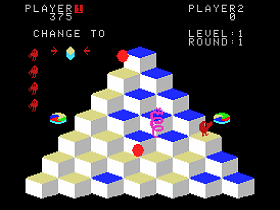 The Game: Q*Bert, a nosey little guy with a propensity for hopping, spends his time hopping around a three-dimensional pyramid of cubes, avoiding Coily the Snake and other assorted purple and red creatures, including a few who operate on a slightly different plane (i.e., they move down the pyramid as if it were rotated one-third). Changing the colors of the top of every cube in the pyramid to the target color indicated at the top left of the screen will clear the pyramid and start the craziness all over again. If Q*Bert is hit by an enemy or falls off the pyramid, he hits bottom with a resounding, arcade- cabinet-shaking splat and a burst of incomprehensible obscenity! (Parker Brothers, 1983)
The Game: Q*Bert, a nosey little guy with a propensity for hopping, spends his time hopping around a three-dimensional pyramid of cubes, avoiding Coily the Snake and other assorted purple and red creatures, including a few who operate on a slightly different plane (i.e., they move down the pyramid as if it were rotated one-third). Changing the colors of the top of every cube in the pyramid to the target color indicated at the top left of the screen will clear the pyramid and start the craziness all over again. If Q*Bert is hit by an enemy or falls off the pyramid, he hits bottom with a resounding, arcade- cabinet-shaking splat and a burst of incomprehensible obscenity! (Parker Brothers, 1983)
Memories: With a huge advantage over the other consoles of its generation, the Colecovision should’ve been able to play the best game of Q*Bert in town. And the graphics are probably the best console rendition that the game got prior to the NES era. Where this Q*Bert makes one want to jump off the pyramid is in the controller.